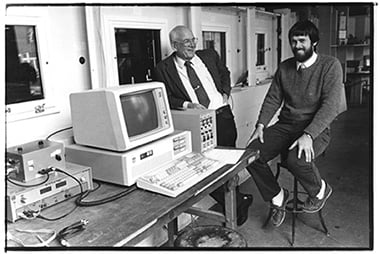
(Photo by Will Kirk / Homewood Photography)
After 25 years at the Whiting School of Engineering, including nine years as dean, Nicholas Jones announced in April that he was stepping down as WSE’s inaugural Benjamin T. Rome Dean at the end of June to become Penn State University’s next executive vice president and provost.
”Nick has been a true Citizen of the University, and he leaves us having transformed the Whiting School of Engineering.” Raimond Winslow, director of the Johns Hopkins Institute for Computational Medicine.
Jones spent all but two years of his career at Johns Hopkins and during his tenure—as a faculty member, department chair, and dean—played an integral role in efforts that not only transformed the Whiting School’s academic programs, research mission, and physical campus but that increased significantly the Whiting School’s role within the university.
“As dean, Nick drew upon his own experiences as an educator to realize his remarkable vision for what engineering education should be,” says Kevin Hemker, who holds the Alonzo G. Decker Chair in Mechanical Engineering. “And as much as students learned from Nick in the classroom, I have no doubt that the personal exchanges that took place in the lab, the hallways, and on the quad were as effective and important in the education of scores of young Hopkins engineers.”
Rai Winslow, the Raj and Neera Singh Professor and director of the Institute for Computational Medicine, says, “Nick came to Johns Hopkins University with a clear vision of how the Whiting School of Engineering could grow to its full potential. He understood the fundamentally important role that multidisciplinary research now plays in all areas of science and engineering. He nurtured its growth by empowering faculty to create centers and institutes that bring together investigators with diverse skills and perspectives to tackle important questions.”

for Nick Jones, and both contributed greatly to the field of wind engineering.
With the additions of Hackerman Hall and Malone Hall (now under construction) and the recent naming of Croft Hall, the “Engineering Quad” has been transformed under Jones’ leadership. These facilities reflect not only the growth in cross-disciplinary research shepherded by Jones but also his ability to build support—across faculty, alumni, university leadership, donors, and friends—for a shared vision for the Whiting School.
A native of New Zealand, Jones arrived at Hopkins in 1986 after completing his PhD at Cal Tech. He joined the faculty as an assistant professor in the Departpartment of Civil Engineering, where he was recruited by department by department chair Ross Corotis, who became Jones’ professional mentor. Corotis, now a professor at the University of Colorado at Boulder, recalls that Jones established the department’s computer system and organized events for undergraduate and graduate students. In addition, “he and Bob Scanlan, probably the leading bluff-body aeroelastician in the world, became a team. They developed the Corrsin wind tunnel, got research funds for instrumentation, and mentored a large group of doctoral students, many of whom have gone on to successful careers in academia.”

of Shriver Hall after Jones is named the inaugural
Benjamin T. Rome Dean. University trustee
emeritus Clark endowed the deanship in honor of
his mentor and business colleague Ben Rome,
a 1925 civil engineering graduate.
(Photo by Will Kirk / Homewood Photography)
As Jones ascended the ranks at the Whiting School, he received multiple teaching awards and oversaw an active research program in the fields of structural dynamics, flow-induced vibration, and wind engineering—all while earning a campuswide reputation as a skilled Ultimate Frisbee player. In 1999, Jones was named chair of civil engineering, a position he held until 2002 when he left Hopkins to become chair of the University of Illinois at Urbana-Champaign’s top-ranked civil and environmental engineering department. In 2004, he returned to Homewood when he was named the Whiting School’s fourth dean.
Judy Mitrani-Reiser, now an assistant professor of civil engineering in the Whiting School, began her Hopkins career as a postdoc, working under Jones’ guidance. The first time they met, Mitrani-Reiser says she was thrilled to discover they had many overlapping interests. “He’s not only fantastic to brainstorm with and helped me identify important research topics, but he taught me how to interact with faculty, staff, and students. Even more important, he taught me that when you see the value in something, you can find a way to make it happen.”
Jones says that academic leadership is a matter of “asking the right questions, really listening to the answers, and ensuring that everyone is working toward a common purpose.” His greatest accomplishment as dean, he says, was, “pulling together an extraordinary team of people who relish challenges, are committed to excellence, and believe in and live the school’s mission.” According to Jones, it is because of his team’s work that the Whiting School has increased its collaborative, trans-disciplinary research and entrepreneurial ventures, expanded its academic offerings, and seen exponential growth in undergraduate applications, while attracting top faculty and graduate students.
Looking ahead to his new role, Jones says, “This amazing community at Johns Hopkins has been my family for so long and it is hard to say goodbye. So I won’t. Hopkins will always be a special place to me. But I am also excited to begin this new chapter at Penn State.”




